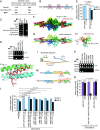A meiotic driver hijacks an epigenetic reader to disrupt mitosis in noncarrier offspring
- PMID: 39485795
- PMCID: PMC11551393
- DOI: 10.1073/pnas.2408347121
A meiotic driver hijacks an epigenetic reader to disrupt mitosis in noncarrier offspring
Abstract
Killer meiotic drivers (KMDs) are selfish genetic elements that distort Mendelian inheritance by selectively killing meiotic products lacking the KMD element, thereby promoting their own propagation. Although KMDs have been found in diverse eukaryotes, only a limited number of them have been characterized at the molecular level, and their killing mechanisms remain largely unknown. In this study, we identify that a gene previously deemed essential for cell survival in the fission yeast Schizosaccharomyces pombe is a single-gene KMD. This gene, tdk1, kills nearly all tdk1Δ progeny in a tdk1+ × tdk1Δ cross. By analyzing polymorphisms of tdk1 among natural strains, we identify a resistant haplotype, HT3. This haplotype lacks killing ability yet confers resistance to killing by the wild-type tdk1. Proximity labeling experiments reveal an interaction between Tdk1, the protein product of tdk1, and the epigenetic reader Bdf1. Interestingly, the nonkilling Tdk1-HT3 variant does not interact with Bdf1. Cryoelectron microscopy further elucidated the binding interface between Tdk1 and Bdf1, pinpointing mutations within Tdk1-HT3 that disrupt this interface. During sexual reproduction, Tdk1 forms stable Bdf1-binding nuclear foci in all spores after meiosis. These foci persist in germinated tdk1Δ progeny and impede chromosome segregation during mitosis by generating aberrant chromosomal adhesions. This study identifies a KMD that masquerades as an essential gene and reveals the molecular mechanism by which this KMD hijacks cellular machinery to execute killing. Additionally, we unveil that losing the hijacking ability is an evolutionary path for this single-gene KMD to evolve into a nonkilling resistant haplotype.
Keywords: chromosome segregation; cryo-EM structure; epigenetic reader; killer meiotic driver; resistant haplotype.
Conflict of interest statement
Competing interests statement:The authors declare no competing interest.
Figures







Comment in
-
Killer meiotic drive executed by two alternative conformations of a single protein.Proc Natl Acad Sci U S A. 2024 Dec 10;121(50):e2420620121. doi: 10.1073/pnas.2420620121. Epub 2024 Dec 2. Proc Natl Acad Sci U S A. 2024. PMID: 39621930 Free PMC article. No abstract available.
Similar articles
-
Structural duality enables a single protein to act as a toxin-antidote pair for meiotic drive.Proc Natl Acad Sci U S A. 2024 Nov 5;121(45):e2408618121. doi: 10.1073/pnas.2408618121. Epub 2024 Nov 1. Proc Natl Acad Sci U S A. 2024. PMID: 39485800 Free PMC article.
-
Diverse mating phenotypes impact the spread of wtf meiotic drivers in Schizosaccharomyces pombe.Elife. 2021 Dec 13;10:e70812. doi: 10.7554/eLife.70812. Elife. 2021. PMID: 34895466 Free PMC article.
-
Atypical meiosis can be adaptive in outcrossed Schizosaccharomyces pombe due to wtf meiotic drivers.Elife. 2020 Aug 13;9:e57936. doi: 10.7554/eLife.57936. Elife. 2020. PMID: 32790622 Free PMC article.
-
The selective elimination of messenger RNA underlies the mitosis-meiosis switch in fission yeast.Proc Jpn Acad Ser B Phys Biol Sci. 2010;86(8):788-97. doi: 10.2183/pjab.86.788. Proc Jpn Acad Ser B Phys Biol Sci. 2010. PMID: 20948174 Free PMC article. Review.
-
Molecular mechanisms underlying the mitosis-meiosis decision.Chromosome Res. 2007;15(5):523-37. doi: 10.1007/s10577-007-1151-0. Chromosome Res. 2007. PMID: 17674143 Review.
Cited by
-
Structural duality enables a single protein to act as a toxin-antidote pair for meiotic drive.Proc Natl Acad Sci U S A. 2024 Nov 5;121(45):e2408618121. doi: 10.1073/pnas.2408618121. Epub 2024 Nov 1. Proc Natl Acad Sci U S A. 2024. PMID: 39485800 Free PMC article.
-
Killer meiotic drive executed by two alternative conformations of a single protein.Proc Natl Acad Sci U S A. 2024 Dec 10;121(50):e2420620121. doi: 10.1073/pnas.2420620121. Epub 2024 Dec 2. Proc Natl Acad Sci U S A. 2024. PMID: 39621930 Free PMC article. No abstract available.
References
-
- Sandler L., Novitski E., Meiotic drive as an evolutionary force. Am. Nat. 91, 105–110 (1957).
-
- Lyttle T. W., Segregation distorters. Annu. Rev. Genet. 25, 511–557 (1991). - PubMed
-
- Austin B., Trivers R., Burt A., Genes in Conflict: The Biology of Selfish Genetic Elements (Harvard University Press, 2009).
-
- Chmatal L., Schultz R. M., Black B. E., Lampson M. A., Cell biology of cheating-transmission of centromeres and other selfish elements through asymmetric meiosis. Prog. Mol. Subcell Biol. 56, 377–396 (2017). - PubMed
-
- Pardo-Manuel de Villena F., Sapienza C., Nonrandom segregation during meiosis: The unfairness of females. Mamm. Genome 12, 331–339 (2001). - PubMed
MeSH terms
Substances
Grants and funding
LinkOut - more resources
Full Text Sources
Molecular Biology Databases

